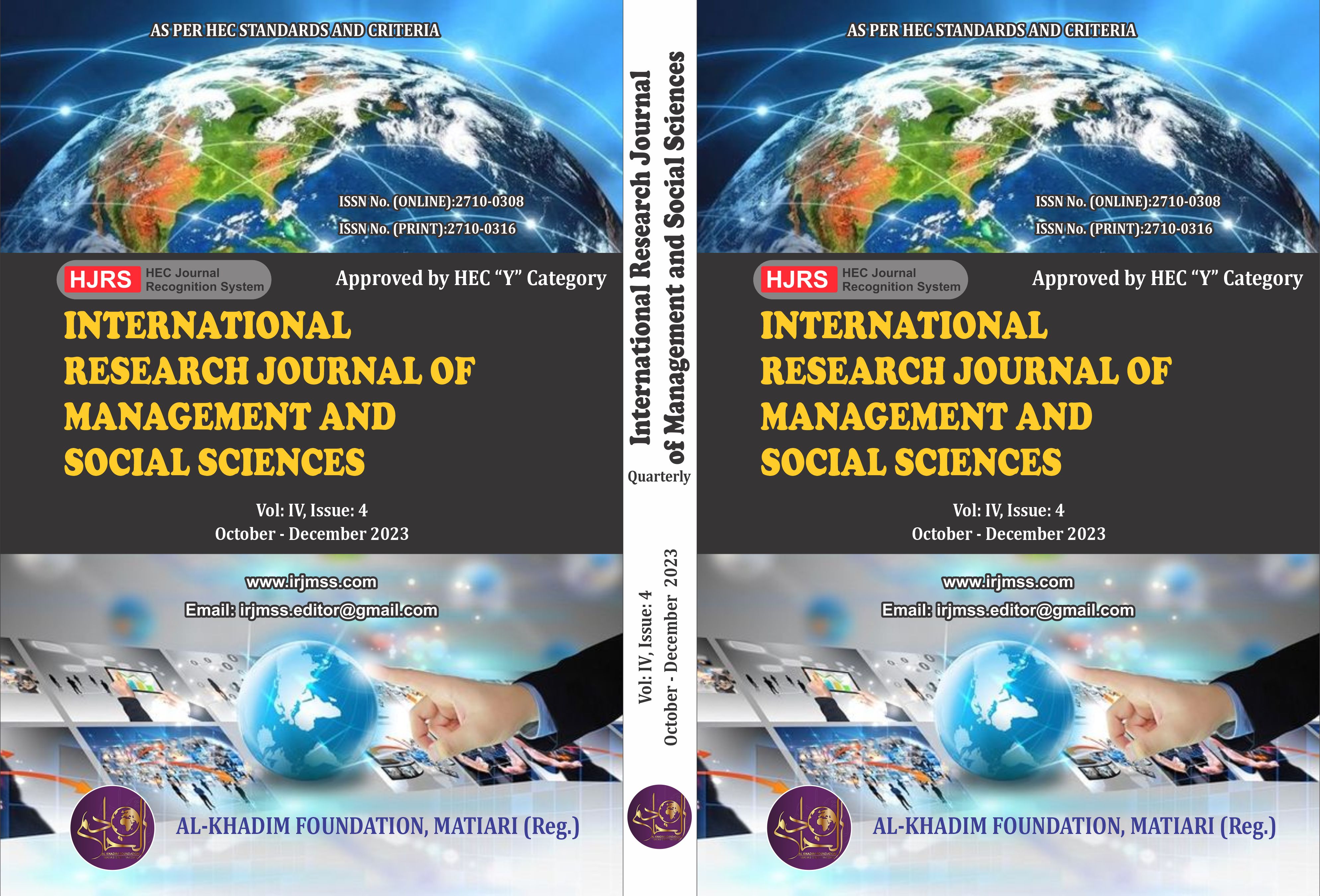The Challenges of Out-of-School Children (Oosc)
Keywords:
primary education, literacy rate, dropout, challengesAbstract
Sindh has the second-highest number around (6 million) of OOSC. More than 50 percent of children drop out at the primary level, and 27% drop out while transitioning from primary to elementary. This Paper investigates segregation across different fields of study. The provincially representative data and literature are used to understand the situation. Analysis showed a positive correlation between access and basic facilities. The Paper conclusively proves that improving access to education, infrastructure, allied services, and provision of teachers will decrease dropouts, hence a reduction in OOSC. It is also essential to address other challenges.
References
Education. (n.d.). UNICEF Pakistan. Retrieved November 7, 2022, from https://www.unicef.org/pakistan/education
Unrepresented Nations and Peoples Organization (UNPO). (2018, February 6).
https://unpo.org/members/7906#:~:text=Sindh%20has%20a%20population%20of%20 over%2047.88%20million
School Education & Literacy Department Government of Sindh. (n.d.). Sindh Education Profile (2019). https://rsu-sindh.gov.pk/contents/profiles/Profiling%202019%2013-01-2020.pdf
UNICEF. (2020). Annual Report. https://www.unicef.org/pakistan/media/3631/file/Annual%20Report%202020.pdf
School Education & Literacy Department, Government of Sindh. (n.d.). Situational Analysis of the Education Sector in Sindh.
https://rsu-sindh.gov.pk/contents/publications/Education-Sector-Analysis-English.pdf
Pakistan Bureau of Statistics. (n.d.). Pakistan Social and Living Standards Measurement Survey (2018-19). https://pslm-sdgs.data.gov.pk/Education/index
School Education and Literacy Department Government of Sindh. (n.d.). School Education Sector Plan and Roadmap (2019-24). Retrieved August 1, 2019, from https://www.globalpartnership.org/sites/default/files/document/file/2020-19-Pakistan- Sindh-ESP.pdf
School Education and Literacy Department Government of Sindh. (n.d.). Sindh Education Profile 2016-17. Retrieved October 5, 2021, from http://www.sindheducation.gov.pk/pages.jsp?page=StatisticsProfile2016-2017
Pakistan Bureau of Statistics, Government of Pakistan. (n.d.). Pakistan Social & Living Standards Measurement Survey (PSLM) 2018-19 National /Provincial (Social Report). Retrieved November 6, 2021, from https://www.pbs.gov.pk/publication/pakistan-social-living-standards-measurement- survey-pslm-2018-19-national-provincial
ASER Pakistan Secretariat & Idara-e-Taleem-o-Aagahi (ITA) Lahore Office. (2020, January 19). Annual Status of Education Report ASER-PAKISTAN 2019. http://aserpakistan.org/document/aser/2019/reports/national/ASER_National_2019.pf
Ali, K., Yaseen, R. M., Makhdum, A. S. M., & Quddoos, A. (2021). Socioeconomic determinants of primary school children dropout: a case study of Pakistan. International Journal of Educational Management, 35(3), ISSN: 0951-354X. https://doi.org/10.1108/IJEM-04-2021-0144
Shahidul, S. M., & Karim, A. H. M. Z. (2015). FACTORS CONTRIBUTING TO SCHOOL DROPOUT AMONG THE GIRLS: A REVIEW OF LITERATURE. European Journal of Research and Reflection in Educational Sciences, 3(2), ISSN 2056-5852. https://www.idpublications.org/wp-content/uploads/2015/02/FACTORS- CONTRIBUTING-TO-SCHOOL-DROPOUT-AMONG-THE-GIRLS.pdf
Holcamp, G. (2009) "Researching the girls' dropout rate in Malawi. Why girls dropout of primary schools and in what way this rate can be reduced." Masters Thesis: 25.
Leung, M. C. M., & Zhang, J. (2008). Gender preference, biased sex ratio, and parental investments in single-child households. Review of Economics of the Household, 6(2), 91–110. https://doi.org/10.1007/s11150-007-9026-x
Brock, C., & Cammish, N. (Eds.). (1996). Factors affecting female participation in education in seven developing countries - Education Research Paper No. 09, (2nd ed.). Department for International Development (DFID). https://core.ac.uk/download/pdf/7052376.pdf
Solotaroff, J., Hashimi, N., & Olesen, A. (2007). Afghanistan Gender Mainstreaming Implementation Note Series, No. 1 : Building Human Capital in Afghanistan. DOCPLAYER. https://docplayer.net/148320559-Building-human-capital-in- afghanistan.html
Carrell, S. E., Page, M. E., & West, J. E. (2010). Sex and Science: How Professor Gender Perpetuates the Gender Gap*. Quarterly Journal of Economics, 125(3), 1101– 1144. https://doi.org/10.1162/qjec.2010.125.3.1101
Grant, M., Lloyd, C., & Mensch, B. (2013). Menstruation and School Absenteeism: Evidence from Rural Malawi. Comparative Education Review, 57(2), 260–284. https://doi.org/10.1086/669121
Burgers, L. (2000). Background and rationale for school sanitation and hygiene education :: IRC. https://www.ircwash.org/resources/background-and-rationale- school-sanitation-and-hygiene-education
BIRDSALL, N., LEVINE, R., & IBRAHIM, A. (2005). Towards Universal Primary Education: investments, incentives, and institutions. European Journal of Education, 40(3), 337–349. https://doi.org/10.1111/j.1465-3435.2005.00230.x
Alif Ailaan. (2014). 25 MILLION BROKEN PROMISES: The crisis of Pakistan's out-of-school children. https://d3n8a8pro7vhmx.cloudfront.net/alifailaan/pages/540/attachments/original/1415950873/25_Million_Broken_Promises_Report.pdf?14159508
Aziz, A., & Haque, M. ul. (2018). Mapping under-researched areas of Population Dynamics in Pakistan. National Institute of Population Studies (NIPS). https://res.nipsportal.com/publications/94.pdf
Government of Pakistan, (2021-22). Pakistan Economic Survey. https://www.finance.gov.pk/survey/chapter_22/Economic%20Survey%202021-22.pdf
Ahmed, F., Ali, Z., Khan, M. S., & Mullazai, M. (2023). A Syntactic Analysis of Compound Noun Phrase of Balochi within the perspective of X-bar Theory. International Research Journal of Management and Social Sciences, 4(3), 289-304.
Mullazai, M., Ali, Z., Khan, M. S., & Ahmed, F. (2023). Agent and Theme Theta Roles in Balochi: A Morphosemantic Analysis. International Research Journal of Management and Social Sciences, 4(3), 332-347.
Pathan, M. S. K. (2022). The Impact of Emotional Intelligence on Leadership Effectiveness. International Research Journal of Management and Social Sciences, 3(3), 1-7.






